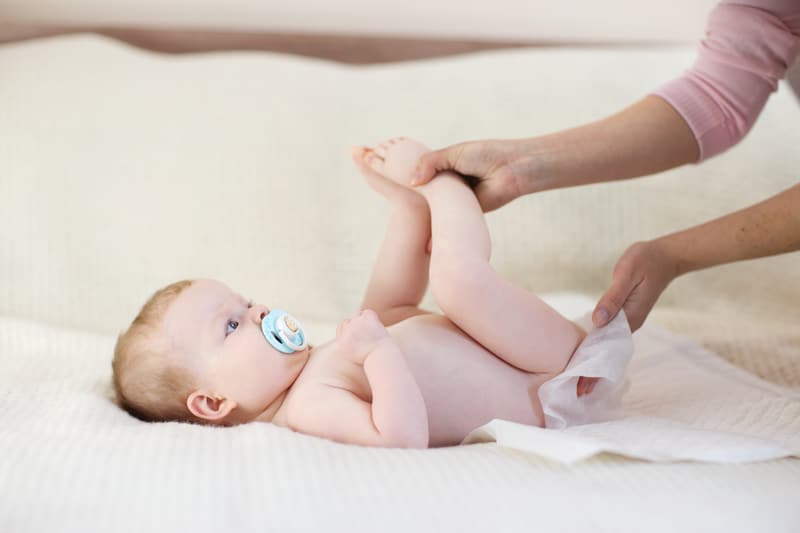
We’re here to help you find a toxic chemical free baby wipe that works for your family. And we’ve got helpful information and facts about the ingredients that are used in conventional baby wipes, making your next trip to the baby aisle stress (and chemical) free.
Choosing Toxic Chemical Free Baby Wipes: the top 7 ingredients to avoid
- Fragrances are linked to a staggering number of health risks. Across multiple research studies, chemicals used to make fragrances are classified as allergens, hormone disruptors, asthma triggers, neurotoxins and carcinogens. What’s worse, the fragrance industry regulates itself and manufacturers are not required to list their fragrance ingredients on product labels. Often only one word, “fragrance”, is used on the label and can hide a cocktail of more than 100 toxic ingredients. This is because fragrances are considered to be “trade secrets”. Make sure to skip any baby wipe that’s fragranced, and you’ll be taking one of the biggest steps you can take to shift to chemical free baby wipes.
- Phthalates – Phthalates aren’t listed on ingredient labels, but they’re typically there if the product is fragranced. Phthalates have been banned for use in products in the European Union, but the United States still permits their use despite the fact that research has shown that these chemicals cause hormonal disruption as well as developmental and reproductive toxicity. They’re dangerous and carcinogenic. Another reason to skip any fragranced baby wipe!
- Parabens – Parabens are synthetic preservatives used in baby wipes as well as cosmetics and personal care products like baby shampoos, haircare products, shaving creams, moisturizers and deodorants. Parabens are linked to a multitude of health risks including cancer, endocrine disruption, reproductive toxicity, neurotoxicity and skin irritation. To avoid them, avoid wipes with ingredients ending in -paraben.
- Phenoxyethanol – Used to limit bacterial growth, phenoxyethanol is a preservative that’s found in baby wipes as well as cosmetics, cleaning, dish soap, laundry and personal care products. Exposure to phenoxyethanol has been associated with a variety of health issues ranging from moderate concern to severe, life-threatening problems including allergic reactions, skin, eye and lung irritation and neurotoxicity. To avoid it, skip any baby wipes with it (or it plus a number) or ingredients that have “-phenoxy-” as part of the name listed on the label.
- Cocamidopropyl Betaine – Cocamidopropyl betaine is a synthetic detergent and surfactant that is used in baby wipes, personal care products, cosmetics and cleaning products. Health concerns around cocamidopropyl betaine include allergic skin reaction, contact dermatitis and environmental toxicity. Increasing rates of sensitization in the population led to cocamidopropyl betaine being named Allergen of the Year in 2004 by the American Contact Dermatitis Society.
- Propylene Glycol – Propylene glycol is found in baby products, cosmetics & detergents and is associated with skin irritation, eye and lung irritation with frequent or prolonged contact and organ system toxicity. To avoid it, skip any baby wipes listing these ingredients: propylene glycol, 1,2-dihydroxypropane, 1,2-propanediol, 2-hydroxypropanol, methylethyl glycol, proane-1,2-diol, 1,2-dihydroxypropane, 1,2-propylene glycol, alpha-propyleneglycol, dowfrost, or methylethylene glycol.
- 1,4 Dioxane – 1,4-dioxane can be found in a multitude of different baby care products, but it is never listed on the ingredient label. That’s because it’s a by-product of the ethoxylation process by which manufacturers attempt to make harsh, raw petroleum-based ingredients less irritating to the skin. In Canada, 1,4-dioxane has been banned for use in cosmetics because of research that’s linked this chemical to the development of cancer and birth defects. 1,4-dioxane can easily and rapidly be absorbed through a baby’s skin in toxic amounts. Stay away from wipes listing these ingredients on labels: polyethylene, polyethylene glycol, sodium laureth sulfate, ceteareth, oleth, oxynol, -xynol, and PEG.
Learn More
We understand that standing around the grocery store reading labels on diaper wipes is not a super appealing use of the limited time parents have. Using resources like the EWG Skin Deep Database can help you find chemical free baby wipes that will function just as well as a conventional brand. From looking up products to learning more about specific ingredients, it takes the guesswork out of finding healthier options for your kids. After all, keeping kids healthy is really one thing all parents can agree is worth our time.



